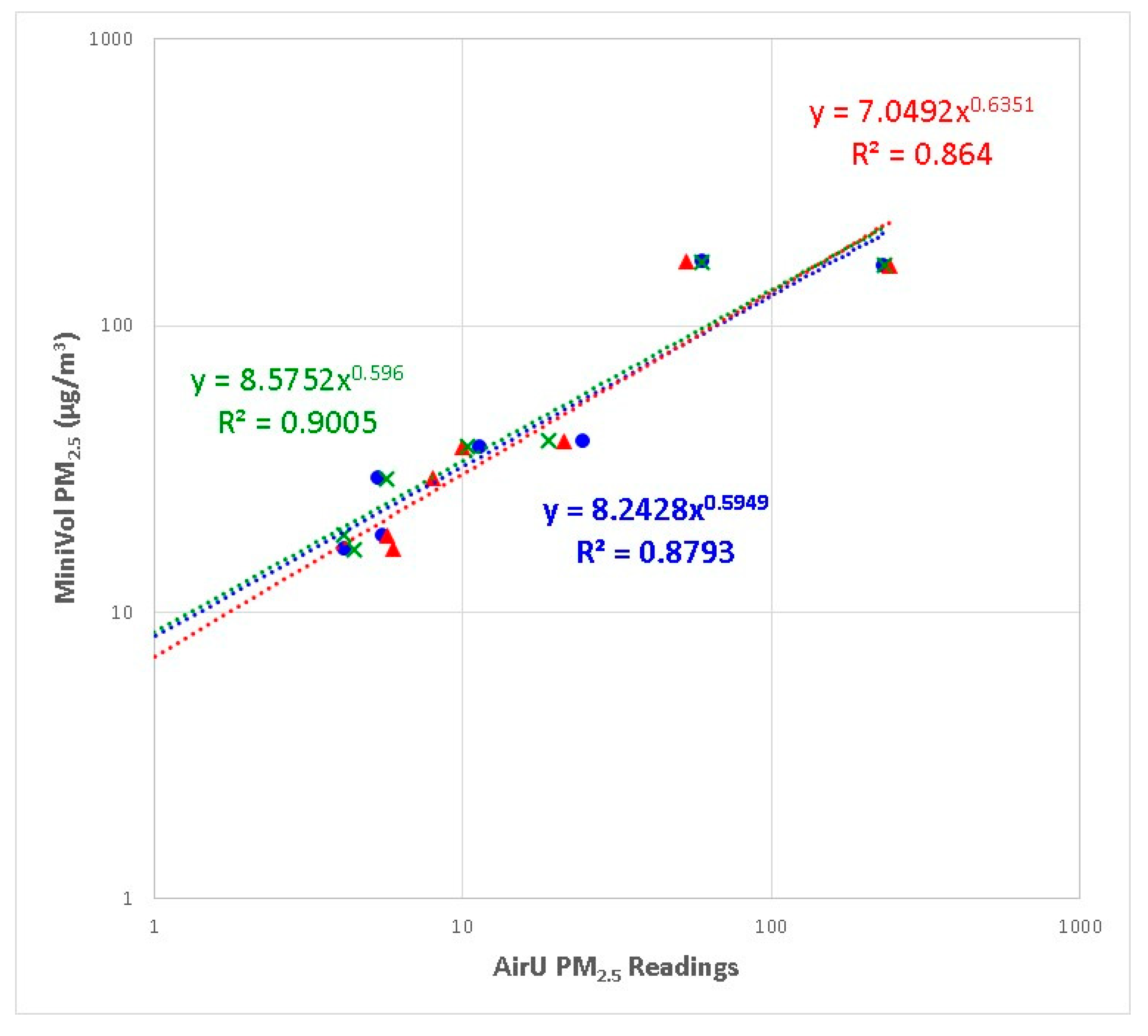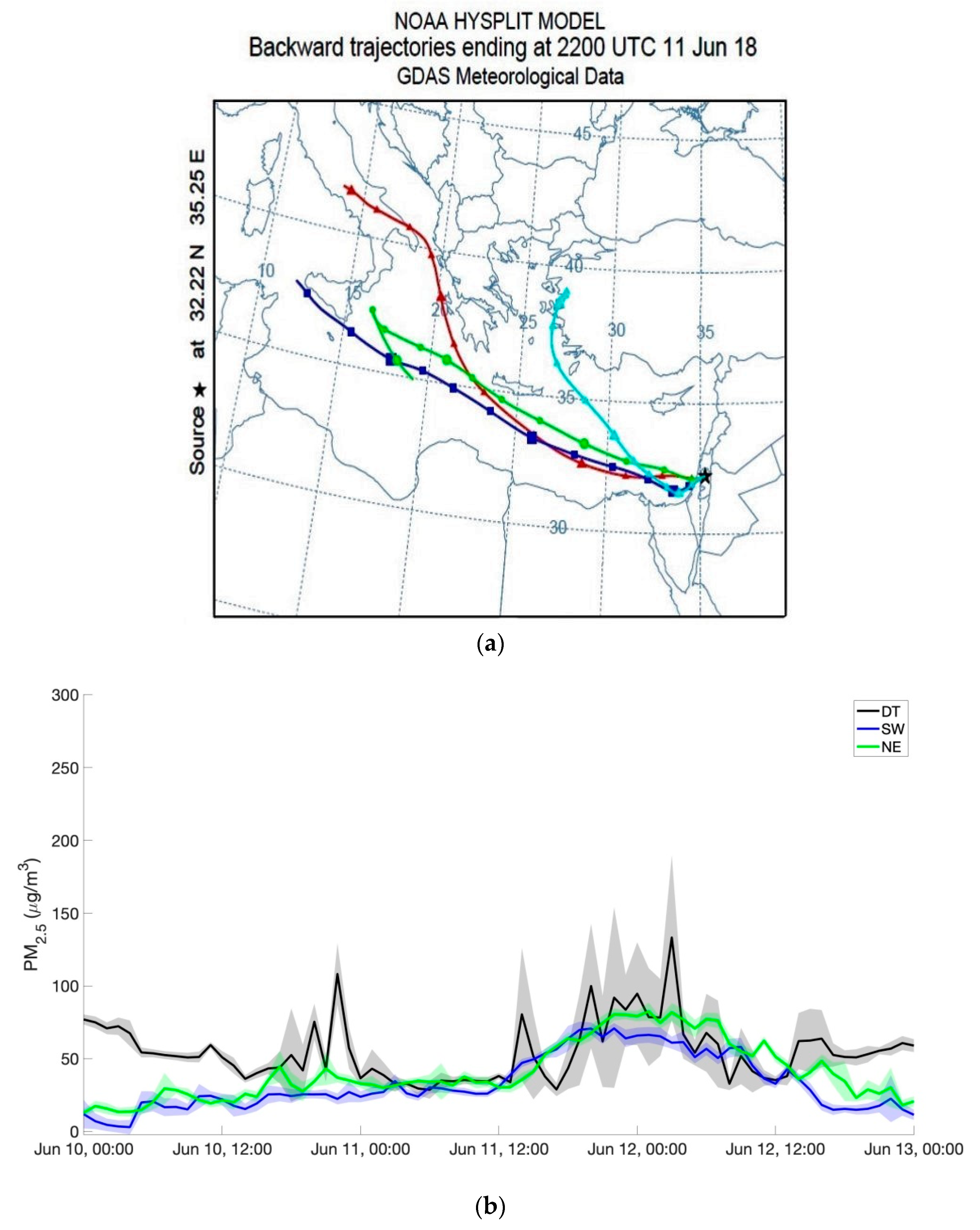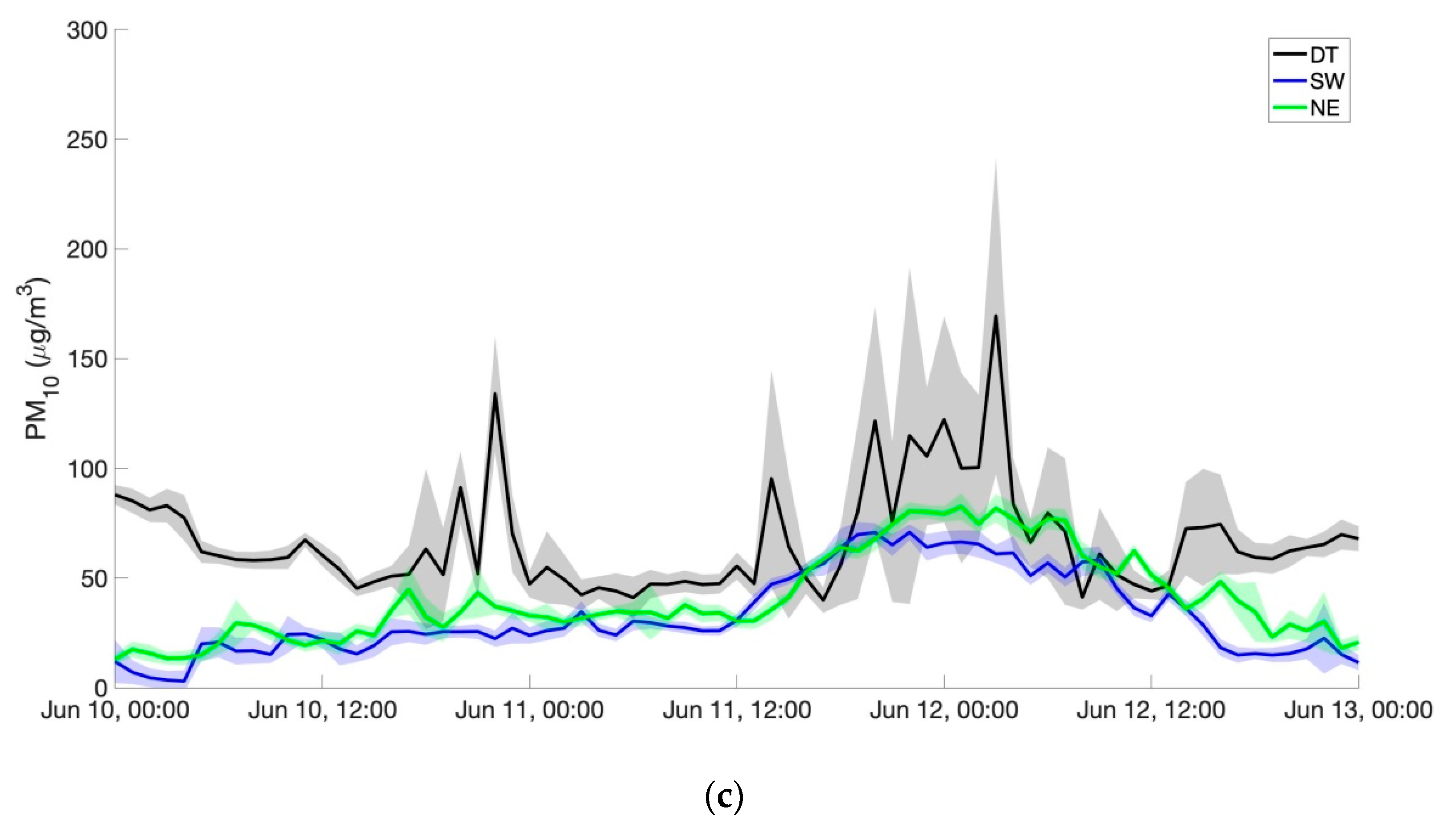Use of Low-Cost Ambient Particulate Sensors in Nablus, Palestine with Application to the Assessment of Regional Dust Storms
Abstract
:1. Introduction
2. Methodology
2.1. Study Area and Site Selection
2.2. Calibration of Low-Cost PM Sensors
2.3. Back Trajectory Analysis Using NOAA-HYSPLIT
3. Results and Discussion
4. Conclusions and Recommendations
Author Contributions
Funding
Acknowledgments
Conflicts of Interest
References
- Davidson, C.I.; Phalen, R.F.; Solomon, P.A. Airborne Particulate Matter and Human Health: A Review. Aerosol Sci. Technol. 2005, 39, 737–749. [Google Scholar] [CrossRef]
- Lippmann, M.; Yeates, D.B.; Albert, R.E. Deposition and clearance of inhaled particles. Br. J. Ind. Med. 1980, 37, 337–362. [Google Scholar] [PubMed]
- Lelieveld, J.; Evans, J.S.; Fnais, M.; Giannadaki, D.; Pozzer, A. The contribution of outdoor air pollution sources to premature mortality on a global scale. Nature 2015, 525, 367–371. [Google Scholar] [CrossRef] [PubMed]
- Li, N.; Hao, M.; Phalen, R.F.; Hinds, W.C.; Nel, A.E. Particulate air pollutants and asthma: A paradigm for the role of oxidative stress in PM-induced adverse health effects. Clin. Immunol. 2003, 109, 250–265. [Google Scholar] [CrossRef]
- Kim, K.-H.; Kabir, E.; Kabir, S. A review on the human health impact of airborne particulate matter. Environ. Int. 2015, 74, 136–143. [Google Scholar] [CrossRef]
- Anderson, J.O.; Thundiyil, J.G.; Stolbach, A. Clearing the Air: A Review of the Effects of Particulate Matter Air Pollution on Human Health. J. Med. Toxicol. 2012, 8, 166–175. [Google Scholar] [CrossRef] [PubMed]
- Krzyzanowski, M.; Cohen, A. Update of WHO air quality guidelines. Air Qual. Atmos. Heal. 2008, 1, 7–13. [Google Scholar] [CrossRef] [Green Version]
- PCBS. Preliminary Results of the Population, Housing and Establishments Census, 2017. 2018. Available online: http://www.pcbs.gov.ps/portals/_pcbs/PressRelease/Press_En_Preliminary_Results_Report-en-with-tables.pdf (accessed on 7 September 2019).
- Jodeh, S.; Hasan, A.R.; Amarah, J.; Judeh, F.; Salghi, R.; Lgaz, H.; Jodeh, W. Indoor and outdoor air quality analysis for the city of Nablus in Palestine: Seasonal trends of PM10, PM5.0, PM2.5 and PM1.0 of residential homes. Air Qual. Atmos. Heal. 2017, 11, 229–237. [Google Scholar] [CrossRef]
- Abdeen, Z.; Qasrawi, R.; Heo, J.; Wu, B.; Shpund, J.; Vanger, A.; Sharf, G.; Moise, T.; Brenner, S.; Nassar, K.; et al. Spatial and temporal variation in fine particulate matter mass and chemical composition: The middle east consortium for aerosol research study. Sci. World J. 2014, 2014, 878704. [Google Scholar] [CrossRef]
- Sayara, T.; Hamdan, Y.; Basheer-salimia, R. Impact of Air Pollution from Quarrying and Stone Cutting Industries on Agriculture and Plant Biodiversity. Resour. Environ. 2016, 6, 122–126. [Google Scholar]
- Kutiel, H.; Furman, H. Dust Storms in the Middle East: Sources of Origin and their Temporal Characteristics. Indoor Built Environ. 2003, 12, 419–426. [Google Scholar]
- Middleton, N.J. Desert dust hazards: A global review. Aeolian Res. 2017, 24, 53–63. [Google Scholar] [CrossRef]
- Krasnov, H.; Katra, I.; Koutrakis, P.; Friger, M.D. Contribution of dust storms to PM10 levels in an urban arid environment. J. Air Waste Manag. Assoc. 2014, 64, 89–94. [Google Scholar] [CrossRef] [PubMed]
- Remoundaki, E.; Bourliva, A.; Kokkalis, P.; Mamouri, R.E.; Papayannis, A.; Grigoratos, T.; Samara, C.; Tsezos, M. PM10 composition during an intense Saharan dust transport event over Athens (Greece). Sci. Total Environ. 2011, 409, 4361–4372. [Google Scholar] [CrossRef] [PubMed]
- Torfstein, A.; Teutsch, N.; Tirosh, O.; Shaked, Y.; Rivlin, T.; Zipori, A.; Stein, M.; Lazar, B.; Erel, Y. Chemical characterization of atmospheric dust from a weekly time series in the north Red Sea between 2006 and 2010. Geochim. Cosmochim. Acta 2017, 211, 373–393. [Google Scholar] [CrossRef]
- GADM, Maps and Data. Available online: https://gadm.org (accessed on 7 September 2019).
- Ministry of Local Governance. GeoMOLG. Available online: geomolg.ps (accessed on 7 September 2019).
- Castell, N.; Dauge, F.R.; Schneider, P.; Vogt, M.; Lerner, U.; Fishbain, B.; Broday, D.; Bartonova, A. Can commercial low-cost sensor platforms contribute to air quality monitoring and exposure estimates? Environ. Int. 2017, 99, 293–302. [Google Scholar] [CrossRef] [PubMed]
- Thompson, J.E. Crowd-sourced air quality studies: A review of the literature & portable sensors. Trends Environ. Anal. Chem. 2016, 11, 23–34. [Google Scholar]
- Schneider, P.; Castell, N.; Vogt, M.; Dauge, F.R.; Lahoz, W.A.; Bartonova, A. Mapping urban air quality in near real-time using observations from low-cost sensors and model information. Environ. Int. 2017, 106, 234–247. [Google Scholar] [CrossRef] [PubMed]
- Holstius, D.M.; Pillarisetti, A.; Smith, K.R.; Seto, E. Field calibrations of a low-cost aerosol sensor at a regulatory monitoring site in California. Atmos. Meas. Tech. Discuss. 2014, 7, 605–632. [Google Scholar] [CrossRef]
- Spinelle, L.; Gerboles, M.; Villani, M.G.; Aleixandre, M.; Bonavitacola, F. Field calibration of a cluster of low-cost available sensors for air quality monitoring. Part A: Ozone and nitrogen dioxide. Sens. Actuators B Chem. 2015, 215, 249–257. [Google Scholar] [CrossRef]
- Mead, M.I.; Popoola, O.A.M.; Stewart, G.B.; Landshoff, P.; Calleja, M.; Hayes, M.; Baldovi, J.J.; McLeod, M.W.; Hodgson, T.F.; Dicks, J.; et al. The use of electrochemical sensors for monitoring urban air quality in low-cost, high-density networks. Atmos. Environ. 2013, 70, 186–203. [Google Scholar] [CrossRef] [Green Version]
- Draxler, R.R.; Hess, G.D. An Overview of the HYSPLIT_4 Modelling System for Trajectories, Dispersion, and Deposition. Aust. Meteorol. Mag. 1998, 47, 295–308. [Google Scholar]
- Stein, A.F.; Draxler, R.R.; Rolph, G.D.; Stunder, B.J.B.; Cohen, M.D.; Ngan, F. NOAA’s HYSPLIT Atmospheric Transport and Dispersion Modeling System. Bull. Am. Meteorol. Soc. 2015, 96, 2059–2077. [Google Scholar] [CrossRef]
- Alam, K.; Qureshi, S.; Blaschke, T. Monitoring spatio-temporal aerosol patterns over Pakistan based on MODIS, TOMS and MISR satellite data and a HYSPLIT model. Atmos. Environ. 2011, 45, 4641–4651. [Google Scholar] [CrossRef]
- Wang, F.; Chen, D.S.; Cheng, S.Y.; Li, J.B.; Li, M.J.; Ren, Z.H. Identification of regional atmospheric PM10 transport pathways using HYSPLIT, MM5-CMAQ and synoptic pressure pattern analysis. Environ. Model. Softw. 2010, 25, 927–934. [Google Scholar] [CrossRef]
- Palestinian Meteorological Department, PMD. Available online: http://pmd.ps (accessed on 7 September 2019).
- Kuula, J.; Mäkelä, T.; Hillamo, R.; Timonen, H. Response characterization of an inexpensive aerosol sensor. Sensors (Switzerland) 2017, 17, 12. [Google Scholar]
- Kelly, K.E.; Whitaker, J.; Petty, A.; Widmer, C.; Dybwad, A.; Sleeth, D.; Martin, R.; Butterfield, A. Ambient and laboratory evaluation of a low-cost particulate matter sensor. Environ. Pollut. 2017, 221, 491–500. [Google Scholar] [CrossRef] [PubMed]
- The Word Air Quality Project. Air Quality Monitoring Devices & Sensor Research. Available online: https://aqicn.org/sensor/ (accessed on 7 September 2019).
- Sayahi, T.; Butterfield, A.; Kelly, K.E. Long-term field evaluation of the Plantower PMS low-cost particulate matter sensors. Environ. Pollut. 2019, 245, 932–940. [Google Scholar] [CrossRef] [PubMed]
- Becnel, T.; Sayahi, T.; Le, K.; Goffin, P.; Butterfield, T.; Kelly, K.; Gaillardon, P.E. A distributed low-cost pollution monitoring platform. Internet Things J. 2018. [Google Scholar]
- AQ-SPEC. Field Evaluation Purple Air PM Sensor Background. 2017. Available online: http://www.aqmd.gov/aq-spec (accessed on 7 September 2019).
- Bulot, F.M.; Johnston, S.J.; Basford, P.J.; Easton, N.H.; Apetroaie-Cristea, M.; Foster, G.L.; Morris, A.K.; Cox, S.J.; Loxham, M. Long-term field comparison of multiple low-cost particulate matter sensors in an outdoor urban environment. Sci. Rep. 2019, 9, 1–13. [Google Scholar] [CrossRef] [PubMed]
- Williams, R.; Vallano, D.; Polidori, A.; Garvey, S. Spatial and Temporal Trends of Air Pollutants in the South Coast Basin Using Low Cost Sensors; U.S. Environmental Protection Agency: Washington, DC, USA, 2018; p. 9.
- Jayaratne, R.; Liu, X.; Thai, P.; Dunbabin, M.; Morawska, L. The influence of humidity on the performance of a low-cost air particle mass sensor and the effect of atmospheric fog. Atmos. Meas. Tech. 2018, 11, 4883–4890. [Google Scholar] [CrossRef] [Green Version]
- Jaafari, J.; Naddafi, K.; Yunesian, M.; Nabizadeh, R.; Hassanvand, M.S.; Ghozikali, M.G.; Nazmara, S.; Shamsollahi, H.R.; Yaghmaeian, K. Study of PM10, PM2.5, and PM1 levels in during dust storms and local air pollution events in urban and rural sites in Tehran. Hum. Ecol. Risk Assess. 2018, 24, 482–493. [Google Scholar] [CrossRef]
- Mahowald, N.; Albani, S.; Kok, J.F.; Engelstaeder, S.; Scanza, R.; Ward, D.S.; Flanner, M.G. The size distribution of desert dust aerosols and its impact on the Earth system. Aeolian Res. 2014, 15, 53–71. [Google Scholar] [CrossRef] [Green Version]
- Weinzierl, B.; Ansmann, A.; Prospero, J.M.; Althausen, D.; Benker, N.; Chouza, F.; Dollner, M.; Farrell, D.; Fomba, W.K.; Freudenthaler, V.; et al. The Saharan aerosol long-range transport and aerosol-cloud-interaction experiment: Overview and selected highlights. Bull. Am. Meteorol. Soc. 2017, 98, 1427–1451. [Google Scholar] [CrossRef]
- EuroWEATHER. Tel Aviv-BenGurion, Observed Conditions, Hourly Data. Available online: http://www.eurometeo.com/english/condition/city_LLBG/archive_select/meteo_Tel Aviv-Ben Gurion (accessed on 7 September 2019).










| Location | March–April | |||||||
| PM2.5 | PM10 | |||||||
| Period Average | Max. Value + (Date/Time) | Min. Value + (Date/Time) | n/N $ | Period Average | Max. Value + (Date/Time) | Min. Value + (Date/Time) | n/N $ | |
| DT | 45.2 ± 3.5 * | 96.5 24 Mar/4am | 3.3 19 Mar/6am | 16/17 | 59.9 ± 4.1 | 136.1 24 Mar/4am | 17.6 18 Mar/11am | 11/17 |
| SW | 33.0 ± 3.1 | 108.9 24 Mar/5am | 0.0 22 Mar/2am | 15/17 | 43.6 ± 3.5 | 135.7 24 Mar/5am | 16.9 25 Mar/10am | 3/19 |
| NE | 36.8 ± 3.6 | 121.1 24 Mar/5am | 3.0 22 Mar /1am | 14/17 | 43.6 ± 3.8 | 138.6 24 Mar/5am | 11.7 26 Mar/2am | 5/19 |
| Location | May–June | |||||||
| PM2.5 | PM10 | |||||||
| Period Average | Max. Value | Min. Value | n/N $ | Period Average | Max. Value | Min. Value | n/N $ | |
| DT | 45.4 ± 3.6 | 133.3 26 May/8am | 5.5 20 May/4pm | 24/25 | 58.5 ± 4.3 | 169.5 29 May/4am | 17.8 27 May/6am | 16/25 |
| SW | 32.1 ± 3.2 | 102.2 26 May/2am | 0.2 24 May/12pm | 18/25 | 42.3 ± 3.5 | 133.4 26 May/2am | 14.5 23 May/5am | 4/25 |
| NE | 36.5 ± 3.6 | 122.3 26 May/4am | 3.1 24 May/12am | 19/25 | 42.7 ± 3.8 | 139.3 26 May/4am | 11.6 28 May/1am | 7/25 |
© 2019 by the authors. Licensee MDPI, Basel, Switzerland. This article is an open access article distributed under the terms and conditions of the Creative Commons Attribution (CC BY) license (http://creativecommons.org/licenses/by/4.0/).
Share and Cite
Khader, A.; Martin, R.S. Use of Low-Cost Ambient Particulate Sensors in Nablus, Palestine with Application to the Assessment of Regional Dust Storms. Atmosphere 2019, 10, 539. https://doi.org/10.3390/atmos10090539
Khader A, Martin RS. Use of Low-Cost Ambient Particulate Sensors in Nablus, Palestine with Application to the Assessment of Regional Dust Storms. Atmosphere. 2019; 10(9):539. https://doi.org/10.3390/atmos10090539
Chicago/Turabian StyleKhader, Abdelhaleem, and Randal S. Martin. 2019. "Use of Low-Cost Ambient Particulate Sensors in Nablus, Palestine with Application to the Assessment of Regional Dust Storms" Atmosphere 10, no. 9: 539. https://doi.org/10.3390/atmos10090539





